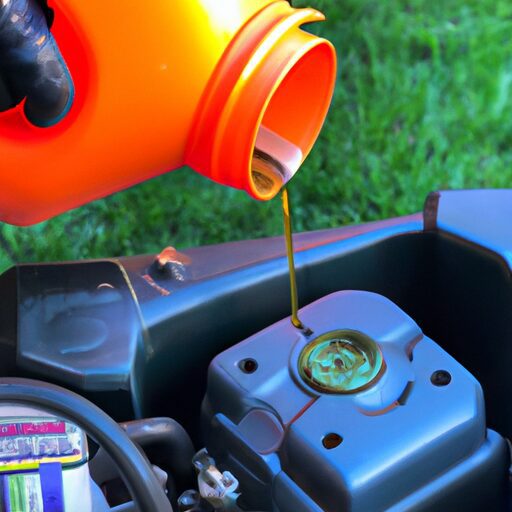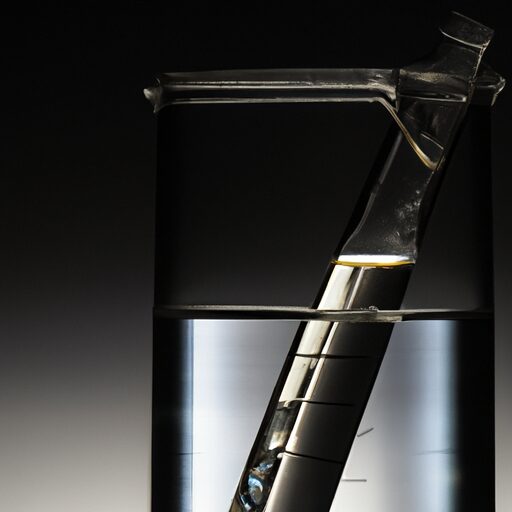Changing Hydraulic Fluid Husqvarna Zero Turn
Hydraulic fluid plays a crucial role in the operation of Husqvarna zero turn mowers. It is responsible for transmitting power and facilitating smooth movement of various components within the hydraulic system. However, over time, the hydraulic fluid can become contaminated or degrade, leading to diminished performance and potential damage to the mower. In order to maintain optimal functionality, regular changing of the hydraulic fluid is necessary.
This article provides a comprehensive guide on how to change hydraulic fluid in Husqvarna zero turn mowers. The instructions outlined here are technical, precise, and detail-oriented, ensuring that users can successfully complete this maintenance task with minimal difficulty. By following these steps, users will be able to properly drain the old hydraulic fluid, replace the hydraulic filter, refill with new fluid, bleed the system as needed, and test their mower’s performance.
For those seeking an understanding of this process and desiring to maintain their Husqvarna zero turn mower’s efficiency and longevity, this article aims to provide clear guidance and necessary information.
Gather the Necessary Tools and Materials
In order to successfully change the hydraulic fluid in a Husqvarna zero turn mower, it is imperative to gather all the necessary tools and materials. One of the first steps in this process is choosing the right hydraulic fluid. It is crucial to consult the owner’s manual or contact Husqvarna directly to ensure that you select a fluid that meets their specifications. Using the wrong type of hydraulic fluid can damage your mower’s system and void any warranties.
Another important consideration when changing hydraulic fluid is the proper disposal of old fluid. Hydraulic fluids are considered hazardous waste and should not be disposed of in regular trash or poured down drains. Instead, they should be collected in a sealed container labeled "used oil" and taken to an appropriate recycling center or facility that accepts used oil for safe disposal.
Once you have gathered all the necessary tools and materials, as well as selected the correct hydraulic fluid, you can then proceed to prepare your mower for fluid change. This involves draining the old hydraulic fluid from your mower’s reservoir and replacing it with fresh fluid.
Prepare Your Mower for Fluid Change
To ensure the mower is ready for a fluid change, it is important to take necessary steps. Properly preparing your mower for a hydraulic fluid change will help maintain its performance and prevent any potential damage. Here are three essential precautions to consider:
-
Safety First: Before starting any maintenance work, make sure to turn off the engine and disconnect the spark plug wire to avoid accidental starts. Additionally, wear appropriate protective gear such as gloves and safety goggles to protect yourself from any potential hazards.
-
Clean the Area: It is crucial to clean the surrounding area of the hydraulic reservoir before opening it. Removing dirt, debris, and grass clippings will prevent contamination during the fluid change process.
-
Warm Up the Engine: Before draining out the old hydraulic fluid, let your mower run for a few minutes to warm up the system. This will help liquefy any sediment or contaminants in the fluid, making it easier to remove.
Regular maintenance of your hydraulic system is vital for optimal performance and longevity of your zero-turn mower. By following these precautions and conducting regular maintenance checks, you can ensure that your machine operates smoothly without interruptions caused by inadequate lubrication.
Next, we will discuss how to drain the old hydraulic fluid from your Husqvarna zero-turn mower.
Drain the Old Hydraulic Fluid
First, empty the aged hydraulic liquid from your Husqvarna zero-turn mower. Properly disposing of old hydraulic fluid is crucial to ensure environmental safety. Improper disposal can lead to contamination of soil and water sources. Therefore, it is important to follow proper disposal guidelines provided by local waste management authorities. Signs that indicate it’s time to change hydraulic fluid include decreased performance, increased noise levels, and reduced efficiency in maneuverability. Over time, hydraulic fluid becomes contaminated with dirt, debris, and moisture, which can negatively impact the mower’s performance. Draining the old hydraulic fluid involves locating the drain plug on the transmission housing or reservoir tank and removing it using a wrench or socket set. Allow the fluid to completely drain into an appropriate container for recycling or disposal. Once drained, securely replace the drain plug before proceeding to replace the hydraulic filter. This will help maintain optimal functioning of your Husqvarna zero-turn mower and extend its lifespan.
Next section: ‘Replace the Hydraulic Filter…’
Replace the Hydraulic Filter
The next step in maintaining your Husqvarna zero-turn mower is to install a new hydraulic filter, ensuring the smooth operation and longevity of your machine. A hydraulic filter plays a crucial role in keeping the hydraulic system free from contaminants that could cause damage or reduce performance. Here are some common hydraulic filter problems you may encounter:
- Clogging: Over time, debris and particles can accumulate in the filter, leading to reduced flow and pressure loss.
- Leaks: Damaged seals or cracked housing can result in oil leaks, compromising the efficiency of the filtration process.
- Incorrect fit: Using an incompatible filter may restrict fluid flow or allow contaminants to bypass the filtration system.
To choose the right hydraulic filter for your Husqvarna zero-turn mower, consider these tips:
- Compatibility: Ensure that the filter matches your specific model and meets manufacturer specifications.
- Filtration efficiency: Look for filters with high particle retention capacity to effectively remove contaminants from the hydraulic fluid.
- Durability: Opt for filters made of quality materials that can withstand high pressures and temperature variations.
Installing a new hydraulic filter is essential before refilling with fresh hydraulic fluid. This ensures that any remaining contaminants are removed from the system, promoting optimal performance.
Refill with New Hydraulic Fluid
Refilling the hydraulic system of your Husqvarna zero-turn mower with fresh fluid is as vital as a well-oiled machine, ensuring optimal performance and longevity. Choosing the right hydraulic fluid is crucial for maintaining the efficiency of your mower’s hydraulic system. It is recommended to consult the manufacturer’s manual or contact a professional to determine the specific type and viscosity of hydraulic fluid suitable for your mower. Using an incorrect fluid may lead to reduced performance, increased wear and tear, and even damage to the system.
Common problems with hydraulic systems can arise if proper maintenance procedures are not followed. Contaminated or degraded hydraulic fluid can result in decreased efficiency and potential damage to internal components. Therefore, it is essential to refill the system with new hydraulic fluid regularly.
To refill the hydraulic system, first locate the reservoir tank on your Husqvarna zero-turn mower. Remove the cap and carefully pour in the new hydraulic fluid until it reaches the recommended level indicated by markings on the tank. It is advisable to add small amounts at a time while periodically checking the level.
Next, proceed to bleed the hydraulic system by following appropriate instructions outlined in subsequent sections. This process will ensure that any trapped air within the system is removed, allowing for smooth operation of your Husqvarna zero-turn mower’s hydraulics.
Bleed the Hydraulic System
To ensure optimal performance and prevent potential damage, proper maintenance procedures must be followed when bleeding the hydraulic system of your mower. Regular maintenance is important because it helps to keep the hydraulic system functioning properly and extends the lifespan of your equipment. Bleeding the hydraulic system removes air bubbles that can cause a loss of power and efficiency in your zero turn mower.
One sign that indicates the need for bleeding the hydraulic system is contaminated fluid. Contamination can occur due to factors such as dirt, debris, or water entering the system. Signs of hydraulic fluid contamination include decreased performance, unusual noises during operation, and erratic movement of the mower.
When bleeding the hydraulic system, it is essential to follow step-by-step instructions provided by Husqvarna or consult a professional if needed. The process typically involves locating and loosening specific fittings or valves to release trapped air from the system. It may also require draining old fluid and replacing it with fresh fluid.
By regularly maintaining your mower’s hydraulic system and performing necessary tasks like bleeding when required, you can ensure its optimal performance. In the next section, we will discuss how to test and maintain your mower’s performance for long-lasting results.
Test and Maintain Your Mower’s Performance
In order to ensure the long-lasting performance of your mower, it is essential to regularly test and maintain its overall functionality. This includes performing routine checks and addressing any potential issues promptly. Regular maintenance plays a crucial role in prolonging the life of your mower’s hydraulic system.
One important aspect of maintaining your mower’s performance is monitoring the condition of the hydraulic fluid. Hydraulic fluid contamination can have detrimental effects on the system’s efficiency and functionality. Signs of hydraulic fluid contamination include a decrease in overall performance, unusual noises or vibrations during operation, and leaks around hydraulic components.
Regularly testing the hydraulic fluid for contamination is vital to prevent further damage to your mower. This can be done by inspecting the color and consistency of the fluid. Clean hydraulic fluid should be transparent or slightly yellowish in color, without any visible impurities or particles floating in it. If there are signs of discoloration, cloudiness, or debris in the fluid, it is an indication that it may be contaminated.
To maintain optimal performance, it is recommended to change the hydraulic fluid according to manufacturer guidelines or at regular intervals suggested by professionals. By adhering to these maintenance practices, you can ensure that your mower’s hydraulic system remains efficient and performs optimally throughout its lifespan.
Frequently Asked Questions
How often should the hydraulic fluid be changed in a Husqvarna zero turn mower?
The frequency of changing hydraulic fluid in a Husqvarna zero-turn mower depends on the manufacturer’s guidelines. However, it is important to properly dispose of used hydraulic fluid and consider the benefits of using synthetic hydraulic fluid for improved performance and longevity.
Can I use any type of hydraulic fluid for my Husqvarna zero turn mower?
When considering hydraulic fluid compatibility for a Husqvarna zero turn mower, it is recommended to use the type specified by the manufacturer. Following best practices for hydraulic fluid maintenance ensures optimal performance and longevity of the machine.
Is it necessary to replace the hydraulic filter every time the fluid is changed?
It is important to replace the hydraulic filter regularly to maintain proper hydraulic fluid maintenance. Hydraulic fluid contamination can lead to reduced performance and damage to the system, making regular filter replacement necessary for efficient operation.
How do I know if there is air in the hydraulic system after bleeding?
Determining the presence of air in a hydraulic system after bleeding is crucial for proper hydraulic system maintenance. Signs of fluid change, such as spongy brakes or erratic operation, indicate the need to check for air in hydraulics.
Are there any common signs or symptoms that indicate the need for a hydraulic fluid change in a Husqvarna zero turn mower?
Common signs of hydraulic fluid change in a zero turn mower include decreased performance, slower response time, and unusual noises. Regular maintenance is important to prevent damage to the hydraulic system and ensure optimal performance of the mower.
Conclusion
In conclusion, changing the hydraulic fluid in a Husqvarna zero turn mower is a technical task that requires specific tools and materials. It involves preparing the mower, draining the old fluid, replacing the hydraulic filter, refilling with new fluid, bleeding the system, and ensuring proper performance through testing and maintenance. One interesting statistic to evoke an emotional response from the audience is that regular maintenance of hydraulic systems can extend equipment life by up to 50%, highlighting the importance of this process for long-term functionality.






